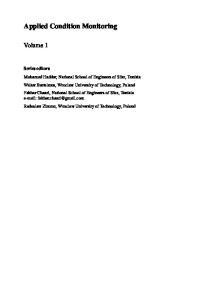Fatigue crack growth in MAR-M200 single crystals
- PDF / 2,129,541 Bytes
- 11 Pages / 594 x 774 pts Page_size
- 9 Downloads / 461 Views
I.
INTRODUCTION
THE utilization
of single crystal Ni-base superalloys in advanced turbine engine applications is an increasingly common occurrence. The reasons for their increased usages are (1) improved creep resistance due to the absence of grain boundaries, (2) lower longitudinal modulus and improved thermal fatigue response, and (3) an increase in the incipient melting temperature by eliminating the grain boundary strengthening elements which are also melting point depressants. ~All these factors contribute to significant increases in the allowable metal temperature and blade stress for the single crystal components, and therefore lead to more efficient turbine engines. The increase in the incipient melting temperature also allows a nearly complete 7' solutionizing during heat treatment, and a reduction in dendritic segregation.~ These effects result in significantly improved properties over conventionally-cast and directionally-solidified (DS) alloys. In contrast to conventionally-cast materials, the mechanical properties of the single crystal alloys are highly anisotropic. Specifically, the elastic modulus, tensile strength, and creep resistance of Ni-base single crystals such as MAR-M2002 and PWA1480*, 3 have all been found to de*PWA is a trademark of Pratt and Whitney Aircraft.
pend on crystallographic orientation. High- and low-cycle fatigue behavior have been characterized for columnargrained and single crystal superalloys as a function of temperature, 4'5 frequency,6 and microstructure. 7 A significant result of these studies on single crystals is that extended crystallographic cracking on {111} planes, Stage I fatigue, 8 *MAR-M is a trademark of Martin Marietta Company.
K. S. CHAN, Senior Research Engineer, and G. R. LEVERANT, Director, Department of Materials Sciences, are with Southwest Research Institute, 6220 Culebra Road, P.O. Drawer 28510, San Antonio, TX 78284. J. E. HACK, formerly with Southwest Research Institute, is a Bernd T. Matthias Fellow at Los Alamos National Laboratory, Los Alamos, NM 87545. Manuscript submitted April 3, 1986. METALLURGICAL TRANSACTIONS A
can be expected at all cyclic frequencies for temperatures up to ~760 ~ and at even higher temperatures for engine excitation frequencies. 6 The effect of crystallographic orientation on the mode of cracking and the crack growth rate has not been studied in previous investigations except for a DS material under thermal-mechanical loading. 9 The more recent fatigue crack growth studies 3,~~ on single crystals have generally focused on the [010] and/or [110] orientations only. A fundamental understanding of the effect of crystallographic orientation on fatigue growth mechanisms in Ni-base superalloy single crystals is therefore still lacking. The objective of the present paper is to examine the roles of crystallography in the fatigue crack growth behavior of MAR-M200 single crystals. In particular, the effect of crystallographic orientation on the mode of cracking and the crack growth rate will be examined.
II.
EXPERIMENTAL PROCE
Data Loading...










